If this is your first time visiting this site, settle in, we’ve got a lot of information about the Amazon’s most mysterious spiritual ambassador — Mother Ayahuasca.
Begin with The Most Popular Posts:
- The Gringo Shaman’s Tea Recipe the title says it all; short point-by-point ayawaska recipe ingredients and cooking description; contextualized by Bajaverde’s meandering quest to experience his first shamanic ceremony.
- Ayahuasca Retreats Directory and Reviews looking to explore the spiritual realm in a safe environment from skilled facilitators and bona fide shamans, you won’t want to miss this page and related articles, reviewing retreat opportunities in Peru, Costa Rica, the USA and Brazil.
- Ayahuasca TV–our latest project collecting the best information in video format available on the web. Commentary, reviews, anthropology and more serve to highlight the ayawaska related content in the videos. Stay tuned, updated frequently.
- Soul Herbs Ayahuasca Recipe–Looking for how to make ayahuasca tea? Here are the top 2 most popular ayahuasca recipes with video instructions. Learn how to make ayahuasca with Mimosa Hostilis and Banisteriopsis Caapi Recipe and Psychotria Viridis(Chacruna) and Banisteriopsis Caapi Recipe
Follow our tweets at @AyaRecipe to be the first to be in the know.
Page Contents
What is Ayahuasca?
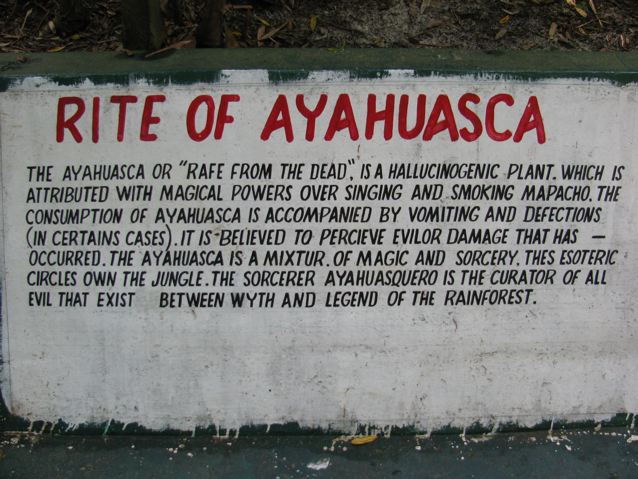
Mural at Quistacocha Zoo, outside Iquitos, Peru. © Bajaverde
Those new to the realms of this spiritual tea often encounter a confusing amount of seemingly contradictory information concerning what exactly constitutes an authentic brew.
Some of the confusion arises because, first, there are many terms and spellings, etymologically speaking, that refer to both the vine–ayahuasca (common botanical referent Banisteriopsis caapi; short form B. caapi)–and the ayahuasca tea that contains the vine and at least one other admixture, usually, but not always, a DMT containing plant such as chacruna (common botanical referent Psychotria viridis).
Yet, depending on the individual preparing the tea recipe–and most notably, the tradition he or she became adept with its preparation–the actual recipe ingredients may contain a plethora of other plants.
The other plants are added to the brew based on the desired healing effects an ayahuascero (someone who is trained in traditional methods to administer the tea, often to referred to as a shaman) determines are necessary to treat or alleviate an illness, be that a psychic or physical illness.
“A shaman is a healer who sings.” –Anon
It would be fair to say that from thousands of accounts from anthropological and ethnobotanical studies there are two key ayahuasca recipe ingredients in any entheogenic brew which work together in synergy to catalyze a subjective experience of altered consciousness for those who partake of the brew.
There are many adjuncts to what could be considered an authentic potion or brew, but its base–essential ingredients, i.e. there are no psychoactive properties without these two essential ingredients–traditionally consist of, at a minimum, the following two ingredients:
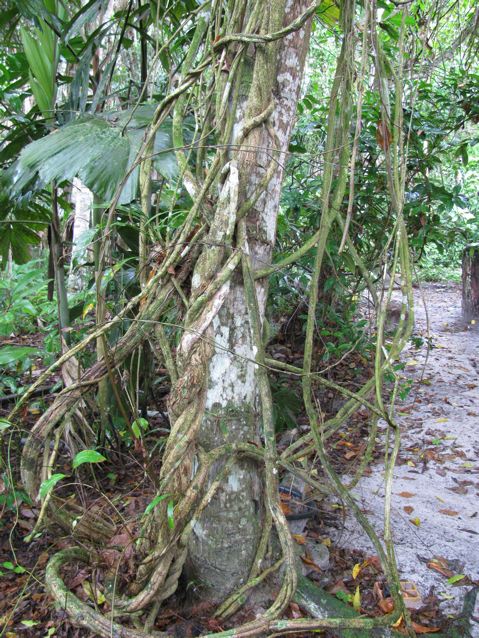
Black ayahuasca (banisteriopsis caapi vine) winding up a tree in Amazon, near Iquitos, Peru.
© Bajaverde
1. The ayahuasca vine, Banisteriopsis caapi (pictured right), and,
2. A DMT containing plant (such as psychotria viridis).
This is the basis of all the best traditional recipes as prepared by indigenous cultures in and around the areas of South America’s Amazon region.
With that said, from a purely clinical or scientific perspective, there are many other plants that could be mixed together to get an effect similar to the traditional brew that can be found in the Amazon.
For example Jonathan Ott has written a book, titled Ayahuasca Analogs, which details around 4000 potential plant combinations that, when brewed together, would result in an ayahuasca-like experience.
On the other hand, to keep true to the cultural and possibly spiritual foundation of ayawaska, as far as encountering the “the vine’s spirit” and all the legendary mythology associated with it, the definitive ingredient for any brew to be considered ayahuasca is Banisteriopsis caapi.
Without including Banisteriopsis caapi in an ostensible brew, you are not preparing or partaking in an experience that any indigenous ayahuascero (shaman) would consider to be ayahuasca — because, it is believed through thousands of years of use and handed-down experiences that the Banisteriopsis caapi serves to connect those who ingest it with a spirit unique to the Banisteriopsis caapi vine; the spirit is thought to be a gatekeeper to another realm and is said to be responsible for miraculous healing, revelations of deep personal insight, protection, divination and a long list of other far-out things: Things which, even today, remain hard to prove in any accepted empirical manner according consensus and repeatability within scientific circles.
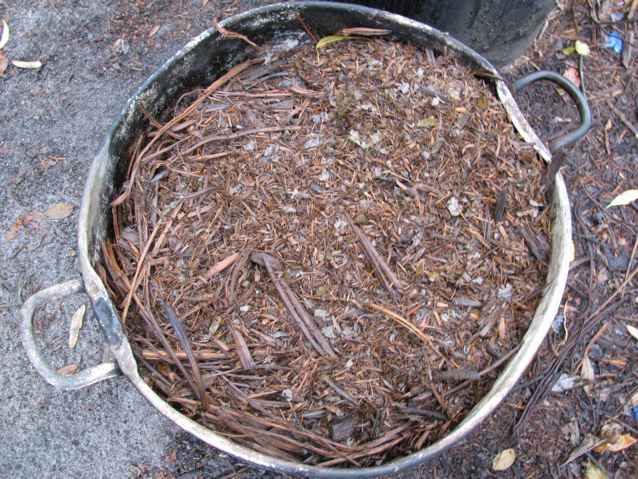
Remains of shredded vine post cooking. © Bajaverde
Ayawaska
Once you grasp what, exactly, is ayahuasca–i.e. a synergistic mixture of–at least–two plant components, one containing DMT (often psychotria viridis) within its structure and the other containing, ideally banisteria caapi (banisteriopsis caapi vine), or another MAO inhibitor–then you may still encounter some confusion in your research as you attempt to understand this mysterious concoction.
Why?
Because the brew goes by many names.
All the names are a result of the widespread use of the tea across a large swath of the South American continent. Numerous separate and distinct people have traditionally utilized the brew traditionally for hundreds and even thousands of years. Add to this, many of these groups were acting individually and also spoke distinct languages, which have morphed and evolved over time.
Then there is the contemporary phenomenon of intense interest in what could be termed the Western World regarding the use of ayawaska, out of curiosity, adventure, connection with the primal, a search for insight and healing.
And what is the result of old culture and traditions colliding with the mobility and instantaneous nature of the modern connected world–a metropolitan mixture of emergent language and terms that serves to befuddle those, “not in the know”.
So, let’s turn on the fog lights and bring some clarity to the miasma of terms that all refer to the star of this site, Banisteriopsis caapi and the tea recipe made from it.
For some of the most common alternative spellings you’ll encounter follow:
- Ayawaska, it is easy to see how you could, upon hearing the imported term ayahuasca make a guess at the spelling and come up with–ayawaska. And here, you wouldn’t be wrong. Ayawaska is the preferred Quechua spelling for both the vine (B. caapi) and the brew.
- Iowaska, this spelling is just a common English language attempt at trying to sound-out the aural pronunciation when one hears, A y a h u a s c a.
- Yajé, also spelled just yaje by English speakers because, most English speakers aren’t conscious of the accent mark; nor is it necessary to understand meaning when speaking our native language, English. Anyhow, yajé finds its roots in the Tucanoan languages. And also from the tucanoan languages we get our next term.
- Yagé, as stated above another spelling and word referring to any active aya brew coming from the Tucanoan lineage. But wait, this word, also seen as just yage (again without the accent) when written by English speakers, has deeper roots in the West. And, you can blame or applaud our ayahuasca-familiar friend William S. Burroughs for popularizing this term by the publication of his book, The Yage Letters. The book is a collection of letters between William S. Burroughs and Allen Ginsberg. In it William S. Burroughs relates accounts of his experiences with the Amazonian great medicine. This book can be considered as one of the first counter culture pillars in what today has become the Ayahuasca tourist industry in the Amazon, where many retreats are on offer to the adventurous tourist. But, for the sake of our defogging exercise in, we can thank William S. Burroughs for popularizing yage as a term used by some English speakers to refer to the more popular and familiar term, ayahuasca.
Now this is not an exhaustive list of all the different spellings from all old and new ayawaska consuming cultures. But, it is a list of the most often used spellings, misspellings and other attempts by English speakers to refer to ayahuasca, both the vine and the brew or tea, when using the internet and searching on the internet for a Banisteriopsis caapi treatment.
Ayawaska, iowaska, yaje and yage, ayahuascu, ayahuaski are all terms that refer to the same “potion” or recipe containing, at the minimum Banisteriopsis caapi and other plants.
Retreats
In a perfect world, the ideal way to gain experience with this plant medicine is with a reputable ayahuascero or shaman–both terms referring to individuals adept in the workings of the medicine and the spirit of inherent in the Banisteriopsis caapi vine.
In recent years there has been a surge of interest from individuals in the Western World–mostly people from the United States, Australia, Japan, France, Spain, the Netherlands, Germany and England–toward the subject of South American shamanism and, specifically, shamans that would be more correctly termed ayahuasceros, or those individuals skilled in the administration and preparation and administration of the brew.
Because of this intense interest and money being spent to satiate curiosity, fulfill a step on a bigger quest, or a alternative route (alternative to Western Medicine) to healing, the entity of the Retreat Center has emerged and the idea of ayahuasca treatment as a healing method for various maladies and even in Peru, ayawaska takes a central role in some drug rehab centers.
If you are traveling to South America for an authentic session, you’ll want to keep an eye on our Retreats page for up-to-date verified facilitators of this plant medicine. As this grows, we’ll compile an .pdf retreat resource.
And, our latest project, compiling the latest research for the best THC Detox.
Buy Ayahuasca
If you are seeking to build a relationship with the Banisteriopsis caapi vine, (and the legendary brew derived from it) there are numerous online sources where you can buy ingredients.
Also, if you are traveling in South America, the ingredients necessary to brew your own–not recommended–brew via a basic and easy recipe can be found in most open markets, such as the San Pedro Market in Cusco, Peru, pictured below, or in the witches alley of Iquitos’, Belen Market.
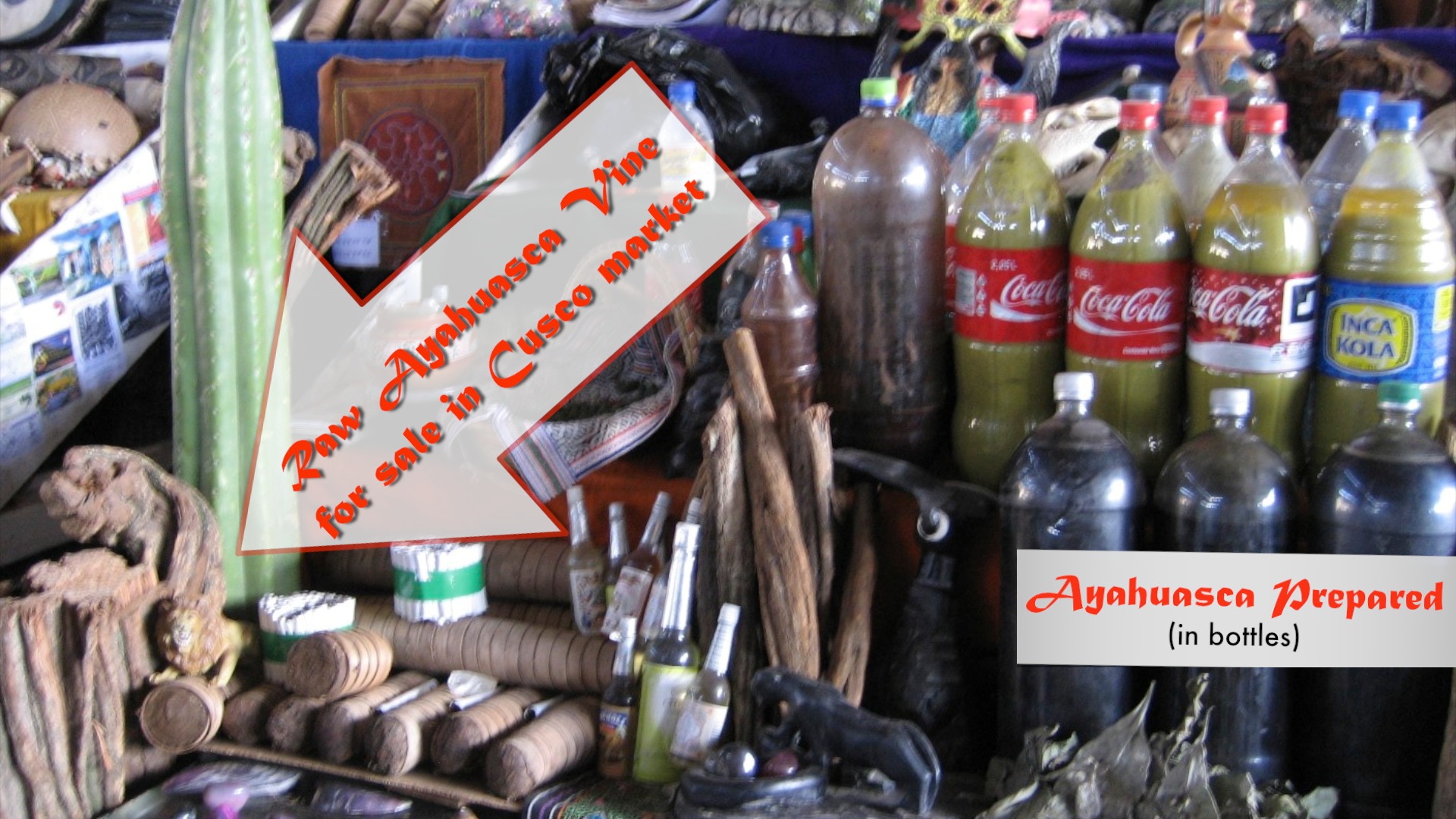
Ayahuasca, both the vine in the raw form and the prepared brew, available for purchase at the San Pedro Market in Cusco, Peru. Also of note is the entheogen, San Pedro, the green columnar cactus, also being sold–visiible in the background and also prepared for consumption as the green sludge in the Coca Cola bottles above the bottles marked ‘Ayahuasca prepared’. © D. Kristophari Madsen
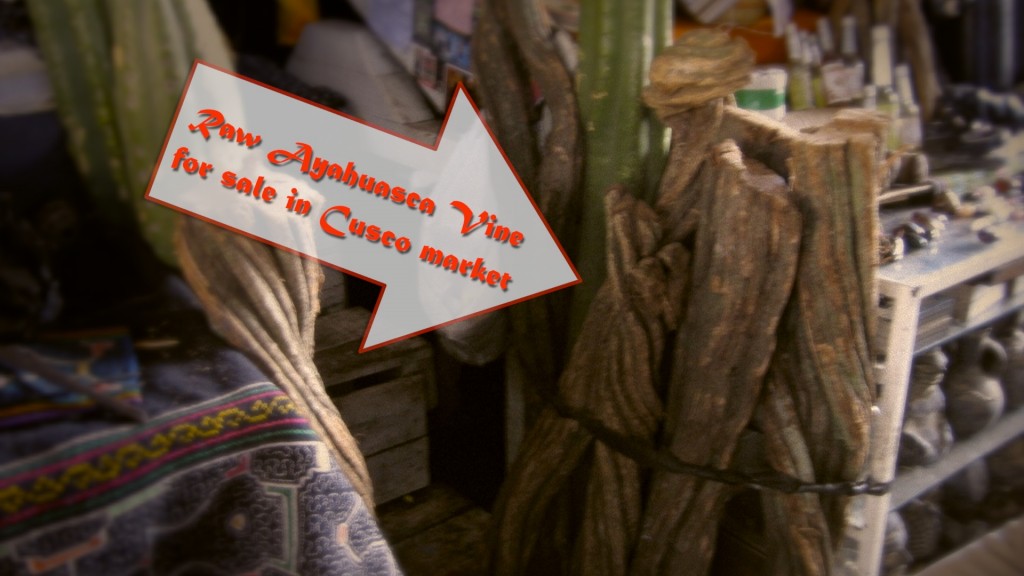
Ayahuasca, raw form, available for purchase at the San Pedro Market in Cusco, Peru. © D. Kristophari Madsen
*For further information about ayawaska, we’ve collected the below resources so you can really get to know this magical entity.
Ten Free Entheogen and Aya Resources on the Web
In addition to this site, there are lots of sites on the web that share tons of mind-bending, thought-provoking, actionable and useful content related to Banisteriopsis caapi.
Consulting our teams collective experience, we have chosen to highlight the following 10 sites because they have proven to supply relevant ayahuasca information that we trust. Listed below, in no particular order, you will find our favorite yage information outposts on the web.
The best online sources serve to inform, educate, challenge and entertain you as you journey about the web on your quest for iowaska knowledge.
If you have a serious interest in the shamanic and spiritual would encountered via this plant, you would benefit by devoting a few hours to grokking the knowledge dropping available gratis on the following 10 sites.
…….
MAPS Psychedelic Bibliography
The Multidisciplinary Association for Psychedelic Studies (MAPS) maintains an extensive web presence that is invaluable to any psychonautic explorer. To access MAPS reserve of ayahuasca related academic resources and studies, you will need to take three steps.
First, go to their Psychedelic Bibliography page here: http://www.maps.org/resources/psychedelic_bibliography/
Next, type ayahuasca into the “search for” box–example below–and click the “search” button.

The MAPS Psychedelic Bibliography search; opens abstract preview and then links to full research documents for download. Convenient access to the best in ayahuasca scientific research freely available to the public on the web.
Then, you will be rewarded with a plethora of abstracts focused on investigating various aspects of the brew.
Moreover, you have free access and can download the full text of the ayahuasca studies via MAPS database. If you’re in school and seeking a primary source that you can reference in a paper, this is a goldmine.
…….
The Ayahuasca Manifesto
Anonymously written and freely distributed, since 2011, as a .pdf document via the web, this curious 50-page document — some claim the manifesto was “channeled” i.e. received knowledge from the spirit of the plant itself — takes liberties suggesting the aya spirit’s special place in the world, what its existence means for humans and the planet, the benefits of consuming the medicine and, furthermore, prescribing a supposed right way to go about consuming the plant.
Dogmatic throughout, the manifesto puts forth insightful ideas and suggestions pertaining to how to interpret the existence of this plant concoction. Read it, but keep in mind, the manifesto author has an agenda; or, is it the ayahuasca spirit’s agenda?
Hard to tell from the entertaining writing style.
The tone of the uncanny Ayahuasca Manifesto can best be understood by the following quote from the beginning of the manifesto:

The Ayahuasca Manifesto is believed by some to be a direct communication from the ayahuasca plant itself. You decide. Quote pulled from the Ayahuasca Manifesto.
You can expand your mind and further explore a document written from the point of view of the yagé spirit by checking-out the complete Ayahuasca Manifesto here:
http://ayahuasqueros.com/pdf/Ayahuasca_Manifesto_Anonymous.pdf
……
Singing to the Plants Blog
Showcases Steve Beyer’s full collection of online articles about the Amazon and many–if not most–post pertaining to his deep knowledge of yagé. Post go all the way back to 2007 and delve into many aspects of the shamanic world in the Amazon. The blog was initially launched to support a book, but–it could be said–the blog has, auspiciously, taken on a life of its own. Deepen your yajé and shamanic studies here: http://www.singingtotheplants.com/blog/
As for the book, Mr. Beyer wrote the authoritative book Singing to the Plants: A Guide to Mestizo Shamanism in the Upper Amazon. If you are looking for a deep understanding of the Shaman’s world, this book is the bridge that will serve to connect, as much as it is possible, indigenous traditions of the Amazon to the western mind. Provides context to the experiences you are sure to encounter on an yagé journey. Comprehensive. Thick. Footnoted. If you had one homework assignment before heading to the Amazon to experience the brew, reading Singing to the Plants is it.
…….
Peru this Week
For those traveling to Peru to participate in a ceremony, Peru this Week tends to report aya related news and trip experiences, you can see the latest and access relevant archives here: http://www.peruthisweek.com/search/?search_head=ayahuasca
…….
The Vaults of Erowid
Erowid’s repute as a go-to source to uncover moderated information on just about any entheogenic substance, plant or otherwise, doesn’t disappoint when it comes to iowaska.
Here you’ll find everything from general information, research, law and spiritual use to non-english resources, experience reports, making yagé and more. Erowid’s collection of iowaska related media is sure to enhance your understanding of what is currently known about this mysterious concoction.
You can get lost in the Vault here: http://www.erowid.org/chemicals/ayahuasca/
…….
SpiritQuest Reference Library

The SpiritQuest Reference Library is a collection of writings and links to all things about this enthralling plant medicine, including shamanism.
There are articles like, “Ayahuasca Goes to Court” and “A Selected Bibliography of Ayahuasca Readings“, though, unlike the MAPS bibliography (see above), SpiritQuest’s bibliography is only a list of books, the book publishers, and the year printed–there are no links to where you can find out more and purchase the books–like the list we have compiled of recommended Yajé Books.
You’ll find the layout of the SpiritQuest Reference Library page to be clunky, but dig in and you will be rewarded with lots of useful information–like “An Ethnobotanical Perspective on Ayahuasca” by Richard Evans Schultes.
These are just two example of the valuable reading you’ll find available on the SpiritQuest Reference Library page, unearth the hidden gems waiting your discovery at the SpiritQuest Reference Library here: http://www.biopark.org/peru/Amazon-library-ethnobotany.html
…….
Homepage of the Amazonian Great Medicine
This site bills itself as a, “A multidisciplinary project devoted to the Spirit Vine Ayahuasca.” There are multiple categories you can explore relating to yagé, including: the Amazon, a general introduction to aya, yajé inspired art and music, spiritual and healing dimensions, research studies on the medicine, and even, a community forum. Contributors to the yagé meme on this site include some well-known entheogenic explorers such as, Dennis McKenna, Steve Beyer and Morgan Maher.
…….
Ayahuasca Info

One of the best things about this site, it is available in English, Dutch, German, Spanish, French and Portuguese; which goes to show, iowaska has been making inroads into cultures outside the Amazon and around the world.
Moreover, there is enough quality content and links on this site to keep you occupied for a few afternoons–you will find a good roundup of some Recipes, a collection of Hoasca .pdf articles, experience reports and an extensive link library to name a few of the highlights you are sure to find useful on this site.
Go deeper down the rabbit hole as you explore all that is available on the excellent resource that is www.ayahuasca-info.com.
…….
Deoxy Ayahuasca and Shamanism
Deoxy.org–short for the deoxyribonucleic hyperdimension, which has been accumulating content since 1993–serves as a portal to many underground topics. With a depth and breadth of mind-bending quantity and quality–this site will pull you in, send you down some meandering pathways and leave you with a few new perspectives at the end of road.
The ayahuasca-shamanic focused page contains dozens of links to yagé themed articles; 214 unique videos about the psychedelic medicine, shamanism and icaros; links to audio files, where you can listen to icaros; and, more–you’re sure to uncover something you’ve never imagined here: http://deoxy.org/shaman.htm#aya.
…….
Aya Wiki
No resource list can be complete without mentioning Wikipedia.
Wikipedia’s yagé page can serve as a starting point to get a general overview about the long history of iowaska. Yet, the real value Wikipedia offers you are the links provided in the notes and reference sections toward the bottom of the page.
At last count the section titled Documentary films about ayahuasca referenced 19 films that involve ayahuasca in some way.

